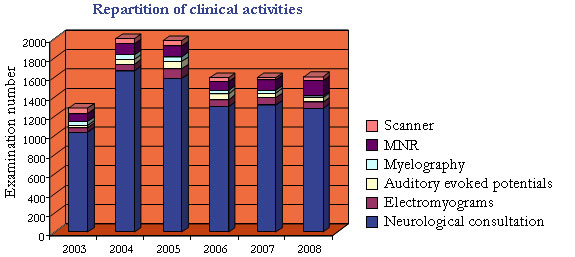
|
clinical activities Veterinarians of the Laboratory of
Neurobiology are involved in the
clinical activities of the Alfort
School of Veterinary Medicine.
Stéphane Blot,
Matthias Le Chevoir,
Jean-Laurent Thibaud and Ane Uriarte ensure the neurological consultations
(15
to 20 % of the medical consultations). They evaluate
congenital
deafness (Auditory evoked
potentials) and
diagnose canine neuromuscular diseases
(electromyograms).
In order to achieve these activities as well as possible, the veterinarians of the lab work in collaboration with the surgery department and the medical imaging department of the In the neuromuscular disease cases, complementary histological examinations are performed in the Laboratory of Neurobiology using specific tools.  In addition, the Laboratory of Neurobiology contributes to the development of genetic tests aiming to detect hereditary neuromuscular diseases : * Detection of the Centronuclear Myopathy in the Labrador Retriever The centronuclear myopathy is characterized by an early muscular atrophy. In collaboration with the Laboratory of Neurobiology, the Alfort School Laboratory of Molecular and Cell Genetics identified the genetic anomaly responsible of the disease. It affects a gene coding for a protein named PTPLA (Protein Tyrosin Phosphatase-Like A) whose function remains currently unknown. However, this discovery allowed the development and the validation of a genetic test detecting the affected individuals (www.labradorcnm.com). * Detection of the Cerebellar Ataxia in the American Staffordshire Terrier The cerebellar ataxia is a disease related to a degeneration of the cerebellum. In the American Staffordshire Terriers, it usually appears between 3 and 5 years of age. It is revealed by balance disturbances, gait disorders and tremors which cause a severe motor incapacity on the short or long run. Recently, the researches of the Laboratory of Neurobiology, undertaken in collaboration with the Alfort School Laboratory of Molecular and Cell Genetics (Dr Marie Abitbol, Dr Laurent Tiret), the Laboratory of Genetic and Development of Rennes (Catherine André) and the Antagene Company, reached the identification of a genetic mutation associated with the disease and the elaboration of a genetic detection test. It is currently commercialised by the Antagene Company (www.antagene.com). |











